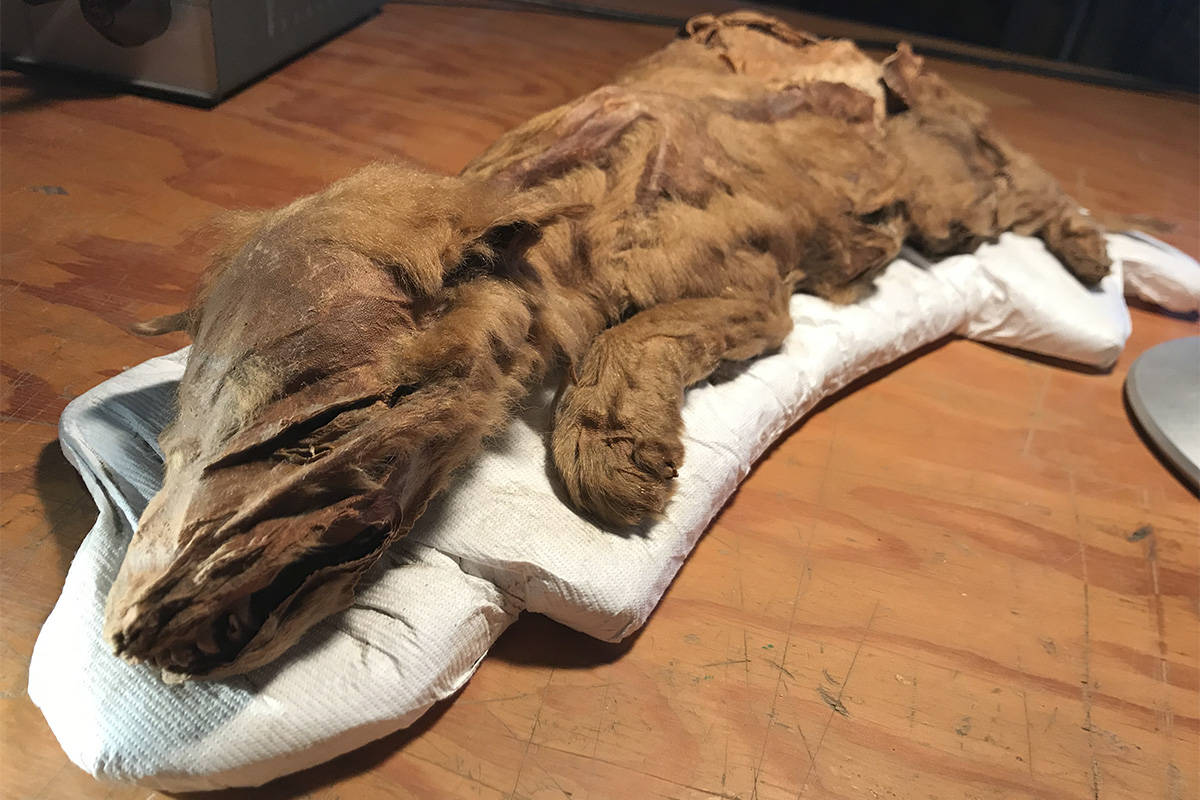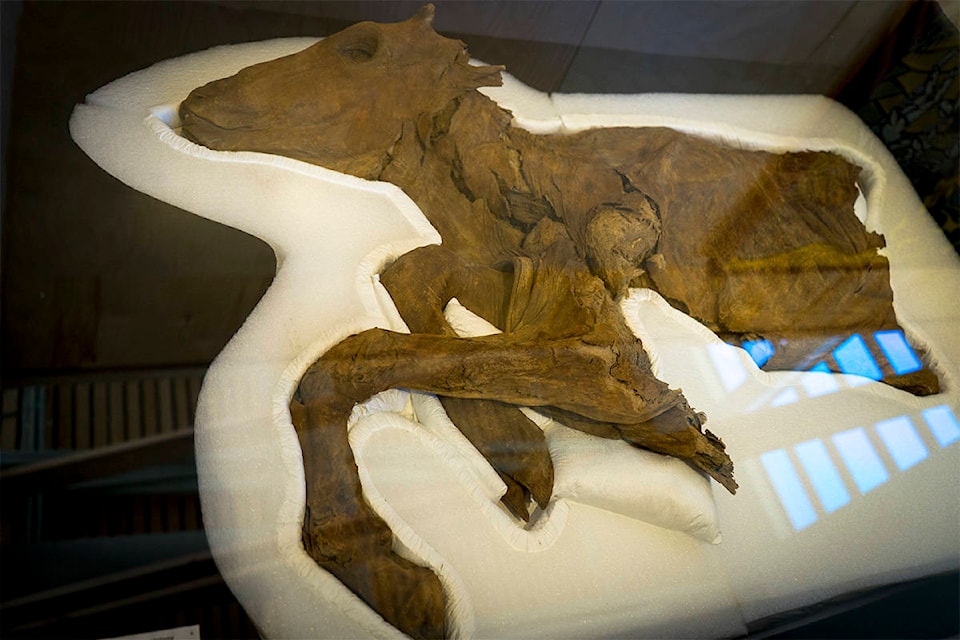Two mummies entombed in permafrost for thousands of years, the ancestors of modern day wolves and caribou, are likely the ticket to understanding how these ancient creatures lived, and survived, during the ice age.
The remains of a wolf pup and caribou, unveiled recently in Dawson City, are astonishingly preserved — complete with hair, skin and muscle. The wolf appears to have its teeth and claws.
Radiocarbon dating shows that the specimens, found by Yukon gold miners, are more than 50,000 years old, said Grant Zazula, a Yukon paleontologist, noting that the discoveries appear to have marked firsts across the globe.
The caribou was discovered near a volcanic ash bed that is 80,000 years old, he said.
“I think that’s the oldest, mummified soft-tissue in the world, as far as we know.”
The wolf, which was less than eight weeks old at death, Zazula said, is turning heads, too. It’s thought to be one-of-a-kind, anywhere, and is more than 50,000 years old.
Both specimens were found in July 2016 — the caribou at a gold mine in Paradise Hill, then, a few weeks later, the wolf pup was discovered at site on Last Chance Creek.
Samples were recently sent to the University of California, Santa Cruz, where genetic testing will take place, Zazula said.
Every year in the Yukon, “thousands” of bones belonging to ice age mammals are found at placer gold mines near Dawson City.
Tony Beets, a celebrity miner showcased on Gold Rush, found the caribou carcass, Zazula said.
Beets did not respond to the News’ request for comment.
Neil Loveless, manager at Favron Enterprises, was there the day the wolf cub was found. He characterized the day as like any other — that is until after a water canon, having washed away some mud, brought into view what Loveless initially thought was moss.
“It didn’t look right, so I gave it a kick,” he said. “It was under a rock, so I gave another little boot, then I decided I better dig it out a bit.”
Seeing that it resembled a dog, he guessed a miner’s pooch had fallen down a shaft to certain death, perhaps during the turn of the century.
“You could see the teeth and everything. I called Grant Zazula’s team and put it in the freezer, in case it was something cool, and then they came out the next day.”
Favron staff typically find ancient bones every day, Loveless said, some belonging to woolly mammoths, short-faced bears or steppe bisons. But to him the discovery of the mummified wolf pup was king.
“To be able to have the opportunity to find these things is something in the world most people don’t have the chance to do,” Loveless said, referring to the partnership with paleontologists. “It’s almost like a hobby or a side project for us, right?”
The landscape, in what is now the Yukon, was markedly different when these animals roamed.
“It was a treeless grassland that was inhabited by woolly mammoths, camels and saber-toothed cats. Almost like the African Serengeti. Full of this crazy diversity,” Zazula said.
The key to this level of preservation is rapid burial, so that the remains aren’t picked away by scavengers, then being encased in a permafrost coffin, he said.
But they aren’t frozen anymore.
“We’re going to be able to do genetic analyses to look at how they’re related to modern populations,” Zazula said.
The weave of different tissues — hair, muscle, skin and bone — will enable scientists to take a deep dive look at the mammals’ diet.
“Most of the time when these mummified carcasses are found in Siberia they’re of extinct animals, but these are both animals that are alive and well in the Yukon,” Zazula said, noting that during the ice age wolves and caribou were uncommon compared to other beasts.
“At the end of the ice age, with the extinction of all the other animals, wolf and caribou populations were able to sort of explode almost and become dominate on the modern landscape. Being able to look at that transition genetically will be a pretty interesting contribution to our understanding of how these species survived in the North for a long time.”
Finding a bone is one thing, Zazula said. Finding mummified remains like these is something else entirely.
After the specimens were found, they were delivered to the Canadian Conservation Institute, in Ottawa, for cleaning.
“They had to take the animals from frozen to air temperature and they had to do that in a very controlled situation so they didn’t get destroyed,” Zuzula said.
The last time mummified remains were discovered in the Yukon was during the early 1990s, he said, when part of a horse was found, though it wasn’t as complete as the wolf and caribou.
These latest mummified animals will stay on display in Dawson for the rest of the month, then they will be incorporated into an exhibit at the Yukon Beringia Interpretive Centre in Whitehorse. The second unveiling is part of a larger redesign of the centre, so it’s unclear when exactly it will be installed, said Cameron Webber, a spokesperson for the Yukon Department of Tourism and Culture, but it could be sometime between April 1, 2019 and Mar. 31, 2020.
“When you actually get to see an animal face-to-face like these, you know, they have hair and skin and dried up eye balls in their sockets and lips and whiskers, it captures you, being able to see the ancient world,” Zazula said.
“To me, I think that’s the most spectacular part of it.”
Contact Julien Gignac at julien.gignac@yukon-news.com

